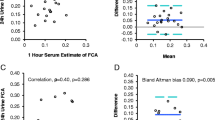Summary
Because intestinal calcium absorption may be an important independent determinant of calcium balance and therefore bone mass, we have studied this factor and other potential predictors in 196 healthy postmenopausal women. Gut calcium absorption was measured in each subject by a stable strontium method and expressed as a fractional absorption. The fractional absorption was significantly negatively correlated with years since menopause (YSM) (r=-0.15 P<0.05), and dietary calcium intake (r=-0.15 P<0.05), and significantly positively correlated with 24-hour urine calcium excretion (r=0.31 P<0.001) and body mass index (r=0.20 P<0.01). Apart from YSM, these factors remained as correlates in multiple regression analysis; the standardized regression coefficient was largest for 24-hour urine calcium excretion (0.32). Fractional absorption of calcium was not correlated with vertebral bone density. Thus, intestinal calcium absorption, although falling with increasing menopausal age and increasing calcium intake, is best correlated with the urine calcium excretion. This indicates either that gut calcium absorption is regulated in response to the magnitude of the urine calcium excretion or that the kidney maintains calcium balance by excreting what is absorbed by the intestine. The mechanisms whereby gut and renal calcium handling are correlated are uncertain.
Similar content being viewed by others
References
Reid IR, Pybus J, Lim TMT, Hannon S, Ibbertson HK (1986) The assessment of intestinal calcium absorption using stable strontium. Calcif Tissue Int 38:303–305
Milsom S, Ibbertson K, Hannan S, Shaw D, Pybus J (1987) Simple test of intestinal calcium absorption measured by stable strontium. Br Med J 295:231–234
Hollis BW (1986) Assay of circulating 1,25-dihydroxyvitamin D involving a novel single-cartridge extraction and purification procedure. Clin Chem 32:2060–2063
St. John A, Davies C, Riley WJ, Kent GN, Brown RC, Aston JP, Weeks I, Woodhead JS (1988) Comparison of the performance and clinical utility of a carboxy-terminal assay and an intact assay for parathyroid hormone. Clin Chim Acta 178:215–223
Dean B, Kolavcic MS, Wark JD, Harrison LC (1988) Chromatography of serum on Sep-pak C18 corrects falsely elevated vitamin D metabolite levels measured by protein binding assay. Clin Chim Acta 176:169–178
Leeuwenkamp OR, van der Vijgh WJF, Hüsken BCP, Lips P, Netelenbos JC (1989) Quantification of strontium in plasma and urine with flameless atomic absorption spectrometry. Clin Chem 35:1911–1914
Gallagher JC, Riggs BL, Eisman J, Hamstra A, Arnaud SB, DeLuca HF (1979) Intestinal calcium absorption and serum vitamin D metabolites in normal subjects and osteoporotic patients. J Clin Invest 64:729–736
Heaney RP, Recker RR, Stegman MR, Moy AJ (1989) Calcium absorption in women: relationships to calcium intake, estrogen status, and age. J Bone Miner Res 4:469–475
Prince RL, Smith M, Dick IM, Price RI, Garcia Webb P, Henderson NK, Harris MM (1991) Prevention of postmenopausal osteoporosis: a comparative study of exercise, calcium supplementation, and hormone-replacement therapy. N Engl J Med 325:1189–1195
Kent GN, Price RI, Gutteridge DH, Allen JR, Blakeman SL, Bhagat CI, St. John A, Barnes MP, Smith M, Evans DV (1991) Acute effects of an oral calcium load in pregnancy and lactation: findings on renal calcium conservation and biochemical indices of bone turnover. Miner Electrolyte Metab 17:1–7
Ljunghall S, Backman U, Danielson BG, Fellström B, Johansson G, Wikström B (1981) Calcium and magnesium metabolism during long-term treatment with thiazides. Scand J Urol Nephrol 15:257–262
Sakhaee K, Nicar MJ, Glass K, Zerwekh JE, Pak CYC (1984) Reduction in intestinal calcium absorption by hydrochlorothiazide in postmenopausal osteoporosis. J Clin Endocrinol Metab 59:1037–1043
Eastell R, Yergey AL, Vieira NE, Cedel SL, Kumar R, Riggs BL (1991) Interrelationship among Vitamin D metabolism, true calcium absorption, parathyroid function, and age in women: evidence of an age-related intestinal resistance to 1,25-dihydroxyvitamin D action. J Bone Miner Res 6:125–132
Morris HA, Need AG, Horowitz M, O'Loughlin PD, Nordin BEC (1991) Calcium absorption in normal and osteoporotic postmenopausal women. Calcif Tissue Int 49:240–243
Author information
Authors and Affiliations
Rights and permissions
About this article
Cite this article
Devine, A., Prince, R.L., Kerr, D.A. et al. Correlates of intestinal calcium absorption in women 10 years past the menopause. Calcif Tissue Int 52, 358–360 (1993). https://doi.org/10.1007/BF00310199
Received:
Revised:
Issue Date:
DOI: https://doi.org/10.1007/BF00310199




